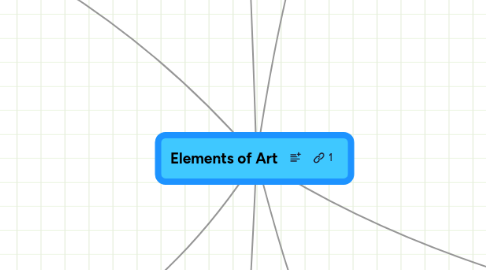
1. Value
1.1. Dark and light
1.2. Example
1.2.1. School work sheet: Black ink on white paper
1.3. Closely related to colours
1.3.1. Yellow, orange
1.3.1.1. Light value
1.3.2. Purple, blue
1.3.2.1. Dark value
1.4. Grey scale
1.4.1. Ten values of grey from light to dark
1.4.2. The farther apart the values are on the scale, the more value contrast
1.5. Contrast
1.5.1. Difference between light and dark vales
1.5.2. Helps us see and understand a 2D work of art
1.5.3. Photographers make black and white prints dramatic
1.6. Changes
1.6.1. Help us 'feel' the roundness of the ball by showing us how light hits the ball and reate shadows on it
1.7. Focal area
1.7.1. Emphasize dark and light value contrasts or intense colour
1.8. Artist
1.8.1. Jean Metzinger
1.8.1.1. 'Tea Time (Woman with a Teaspoon)'
1.8.1.1.1. Strong value contrast
1.8.1.1.2. Cubist in style
1.8.1.1.3. Can be seen as a black and white reproduction
1.8.2. High key paintings
1.8.2.1. Light values
1.8.2.2. Minimum of value contrast
1.8.2.3. Happiness
1.8.2.4. Light
1.8.2.5. Joy
1.8.2.6. Airiness
1.8.3. Low key paintings
1.8.3.1. Dark valued hues
1.8.3.2. Little value contrast
1.8.3.3. Sadness
1.8.3.4. Depression
1.8.3.5. Loneliness
1.8.3.6. Misery
1.9. Atmospheric perspective
1.9.1. Distant features lighter in value than closer features
2. Shape
2.1. An area that contained within an implied line
2.2. Geometrical
2.2.1. Square
2.2.2. Triangle
2.2.3. Circle
2.2.4. Rectangle
2.2.5. Oval
2.2.6. Polygon
2.2.7. Hexagon
2.2.8. Octagon
2.2.9. Pentagon
2.2.10. Parallelogram
2.2.11. Rhombus
2.2.12. Trapezium
2.2.13. also known as rectilinear shapes
2.3. Organic
2.3.1. Freeform
2.3.2. Natural
2.3.3. Also known as curvilinear shapes
2.4. 2 dimension
2.5. 3 dimension
2.6. Pablo Picasso
2.6.1. Uses abstract shapes of things to crete artwork
2.6.2. 'Three Musicians'
2.7. Positive/negative
2.8. outlined/unoutlined
2.9. dark/light valued
2.10. Large/medium/small
2.11. Flat/patterened
3. Texture
3.1. Surface quality
3.1.1. Simulated
3.1.1.1. Dry brush technique
3.1.1.2. Visual texture
3.1.1.3. Smooth painting surfaces appear to be textured
3.1.2. Actual
3.1.2.1. Heavy application of pigment
3.1.2.2. Tactile texture
3.1.2.3. Surface quality we can feel
3.1.2.4. Examples
3.1.2.4.1. Gravel path
3.1.2.4.2. Tree bark
3.1.2.4.3. cat's fure
3.2. Artist
3.2.1. Georges Rouault
3.2.1.1. 'The Old King'
3.2.1.1.1. Painting technique: Impasto
3.2.1.1.2. Heavy texture
3.2.1.1.3. Focal area has strongest value contrast
3.2.1.1.4. Contrast of smooth and textured areas emphasizes heavy textures
3.2.1.1.5. Broken lines and edges emphasize actual textures
3.2.1.1.6. Colour and value contrast
3.3. Variety
3.3.1. Important to interior designers, architects
3.3.1.1. Fabrics
3.3.1.2. Wood
3.3.1.3. Plaster
3.3.1.4. Metal
3.3.1.5. Glass
3.3.1.6. Paper
3.3.1.7. Plastic
3.3.1.8. Paint
3.4. Collage
4. Space
4.1. Actual
4.1.1. Empty
4.1.2. Filled
4.1.3. Has width, height, depth
4.1.4. Real space
4.2. Illusion
4.2.1. Appears 3D in painting
4.2.2. Creates feeling of actual depth
4.2.3. Technique to show space
4.2.3.1. Perspective
4.2.3.2. Values
4.2.3.2.1. Atmospheric, aerial perspective
4.2.3.3. Overlapping
4.2.3.4. Size of shapes
4.2.3.4.1. Object seem close when large
4.2.3.4.2. Object seem far when small
4.2.3.5. When any 2 techniques are combined, sense of space is greatly increased
4.2.4. Linear perspective
4.2.5. One-point perspective
4.2.6. Two-point perspective
4.3. Artist
4.3.1. Robert Henri
4.3.1.1. 'Snow in New York'
4.3.1.1.1. Feeling of space
4.3.1.1.2. One-point perspective line lead to focal area
4.3.1.1.3. Light values and soft edges in the distance; dark values in the foreground
5. Line
5.1. Mark made by a pointed tool
5.1.1. Movement of a tool and pigment
5.1.2. Brush
5.1.3. Pencil
5.1.4. stick
5.1.5. Pen
5.1.6. Ink
5.1.7. charcoal
5.2. Moving dot
5.3. Suggest movement in painting and drawing
5.4. Variety
5.4.1. Thickness, thiness
5.4.1.1. Brush pressure
5.4.2. Angular
5.4.3. Curved
5.4.4. Broken
5.5. Calligraphy
5.5.1. Quality of line that is thick and thin
5.6. Value constrast
5.6.1. Layering of lines
5.6.1.1. Creating shallow depth
5.7. Mark Tobey's 'Calligraphy in white'
5.8. Contour lines
5.8.1. Edges of forms or shapes
5.9. Create values and textures
5.9.1. Hatching
5.9.1.1. placing of lines next to each other
5.9.2. Cross hatching
5.9.2.1. Crossing of parallel lines
5.10. Gestural lines
5.10.1. Indicate action and physical movement
5.11. Implied lines
5.11.1. Dot and short lines moving across the page
5.11.2. Edge of shadow
6. Colour
6.1. Colour wheel
6.1.1. Primary colours
6.1.1.1. Red
6.1.1.2. Yellow
6.1.1.3. Blue
6.1.2. Secondary colours
6.1.2.1. Orange
6.1.2.2. Green
6.1.2.3. Violet
6.1.3. Tertiary colours
6.1.3.1. Red orange
6.1.3.2. Orange yellow
6.1.3.3. Chartreuse
6.1.3.4. Aquamarine
6.1.3.5. Indigo
6.1.4. Analogous colours
6.1.5. Complementary colour
6.1.6. Achromatic colour
6.2. Colour model
6.2.1. Subtractive
6.2.1.1. CMYK
6.2.1.1.1. Cyan
6.2.1.1.2. Magenta
6.2.1.1.3. Yellow
6.2.1.1.4. Black
6.2.2. Additive
6.2.2.1. RGB
6.2.2.1.1. Red
6.2.2.1.2. Green
6.2.2.1.3. Blue
6.3. Intensity
6.3.1. Chroma
6.3.1.1. Purity of a hue
6.4. Value
6.4.1. Lightness or darkness of a hue
6.5. Contrast
6.6. Colour temperature
6.6.1. Warm colour
6.6.1.1. Seem to come forward
6.6.2. Cool colour
6.6.2.1. Recede
6.7. Hue
6.7.1. Add black
6.7.1.1. Shade
6.7.2. Add white
6.7.2.1. Tint
6.7.3. Neutralized
6.7.3.1. Tones
6.8. Satuation
6.9. Symbolism and psychology
6.10. Depends on light/Product of light
6.10.1. Shadows
6.10.1.1. Sense of form
6.11. Colour theorist
6.11.1. Charles Albert Keeley
6.11.1.1. Invented 'The Colour Conundrum', a game which showcased his research.
6.12. Artist
6.12.1. Auguste Renoir
6.12.1.1. Impressionist painter who used colour to show depth and volumn in his paintings
6.12.2. Create illusion of depth by using colour relationship
7. Form
7.1. Volumn
7.2. Mass
7.3. 3 dimensional
7.3.1. Can be viewed from many angles
7.4. Curves
7.5. Angles
7.6. indentations
7.7. extensions
7.8. edges
7.9. space
7.9.1. strong element in establishing sense of form
7.9.2. clustering, overlapping of forms
7.9.3. space between and around objects helps us regconize and identify 3 dimensional forms
7.9.4. Value contrast
7.10. Barbara Hepworth's 'Assembly of Sea Forms
7.11. Architectural form
7.11.1. contains enclosed space for various activities
7.12. Natural form
7.13. Abstract forms
7.14. Realistic forms
7.14.1. depict things as they actually appear
